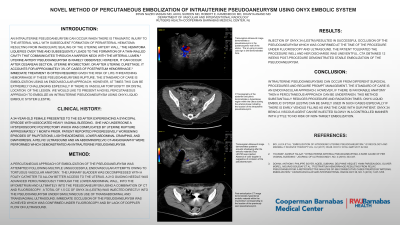Back

Women’s Health
049 - Novel Method of Percutaneous Embolization of Intrauterine Pseudo-aneurysm using Onyx Embolic System

Dhanya Anand, M.D. – Interventional Radiologist, Rutgers-Cooperman Barnabas Medical Center; Akhil Sureen, M.D. – Resident, Rutgers-Cooperman Barnabas Medical Center
Purpose: Intrauterine pseudoaneurysms can occur when there is traumatic injury to arterial wall with subsequent formation of periarterial hematoma resulting from inadequate sealing of the uterine artery wall. Given the risk of life-threatening hemorrhage if these pseudoaneurysms rupture, immediate treatment is often required. The standard of care is embolization using an endovascular approach; however, at times this can be extremely challenging especially if there is vascular tortuosity or a distal pseudo-aneurysm. We would like to present a novel percutaneous approach to embolize an intrauterine pseudoaneurysm using Onyx Liquid Embolic System (LESTM).
Material and Methods: We present a novel percutaneous approach of embolization of an intrauterine pseudoaneurysm using Onyx 34 (LESTM) after multiple endovascular approaches were unsuccessful owing to tortuous anatomy. The urinary bladder was decompressed with a foley catheter to allow access to the uterus. Using a combination of CT and fluoroscopy, a needle was advanced through the myometrium into the pseudoaneurysm. Onyx 34 (LESTM) was injected directly into the pseudoaneurysm under ultrasound guidance. Immediate occlusion of the pseudoaneurysm was achieved which was confirmed under fluoroscopy and ultrasound.
Results: Injection of Onyx 34 (LESTM) resulted in successful occlusion of the pseudoaneurysm which was confirmed at the time of the procedure under fluoroscopy and with color doppler ultrasound. The patient tolerated the procedure well and her discharge was uneventful. CTA obtained 12 weeks post-procedure demonstrated stable embolization of the pseudoaneurysm.
Conclusions: Intrauterine pseudoaneurysms can occur from different surgical procedures and require prompt management. The standard of care is an endovascular approach; however, if there is favorable anatomy then a percutaneous approach can be undertaken. This method substantially reduces procedure and radiation times. Onyx Liquid Embolic System (LESTM) can be safely used in such cases especially if there is early venous filling as was the case with our patient. Onyx 34 being a viscous agent can be injected slowly in a controlled manner with little to no risk of non-target embolization.
Material and Methods: We present a novel percutaneous approach of embolization of an intrauterine pseudoaneurysm using Onyx 34 (LESTM) after multiple endovascular approaches were unsuccessful owing to tortuous anatomy. The urinary bladder was decompressed with a foley catheter to allow access to the uterus. Using a combination of CT and fluoroscopy, a needle was advanced through the myometrium into the pseudoaneurysm. Onyx 34 (LESTM) was injected directly into the pseudoaneurysm under ultrasound guidance. Immediate occlusion of the pseudoaneurysm was achieved which was confirmed under fluoroscopy and ultrasound.
Results: Injection of Onyx 34 (LESTM) resulted in successful occlusion of the pseudoaneurysm which was confirmed at the time of the procedure under fluoroscopy and with color doppler ultrasound. The patient tolerated the procedure well and her discharge was uneventful. CTA obtained 12 weeks post-procedure demonstrated stable embolization of the pseudoaneurysm.
Conclusions: Intrauterine pseudoaneurysms can occur from different surgical procedures and require prompt management. The standard of care is an endovascular approach; however, if there is favorable anatomy then a percutaneous approach can be undertaken. This method substantially reduces procedure and radiation times. Onyx Liquid Embolic System (LESTM) can be safely used in such cases especially if there is early venous filling as was the case with our patient. Onyx 34 being a viscous agent can be injected slowly in a controlled manner with little to no risk of non-target embolization.
